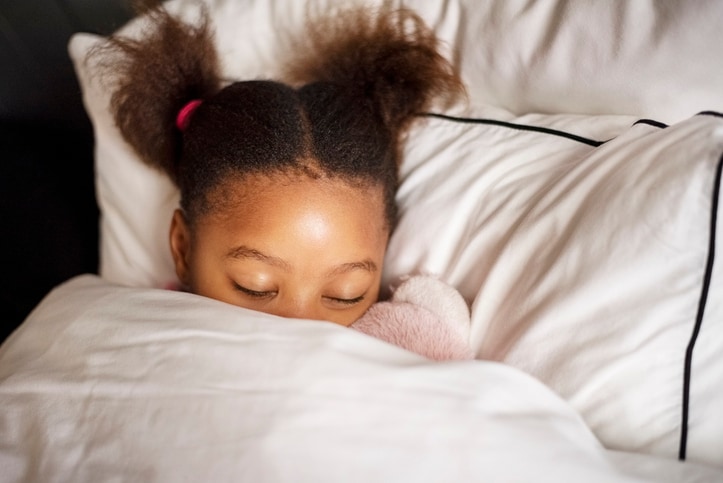In this article
Two times a year, clocks spring forward or fall back for daylight saving time (DST), and the time change threatens to wreak havoc on kid sleep schedules and parent sanity. In fact, researchers say a one-hour shift in sleep disrupts sleep cycles for about a week, sometimes longer. For many families, this may mean early morning wakeups, bedtime resistance or even extra night-waking as kids adjust.
Luckily, there are a few ways to make daylight savings for kids a little easier — on everyone. Here’s how to prepare kids for daylight savings in advance, and how to help kids adjust to daylight saving time once the clocks actually move.
Key takeaways
- Adjust kids’ bedtimes gradually before daylight saving time by 15-30 minute increments over 1-2 weeks.
- Focus on maintaining good sleep habits, like limiting screen time and ensuring enough rest.
- Be flexible during the transition, as it may take up to a week for kids to adjust.
Preparing kids for daylight saving time
If you’re a planner, you can get your kid ready for the time change in advance, putting them to bed a little later (in the fall) or earlier (in the spring) than usual. Here’s how to adjust bedtime for daylight savings:
Move sleep times by small increments
Do it in small increments, gradually working your way to up to a full hour, says Sara Mitchell, a sleep consultant with Helping Babies Sleep in Mountain View, California.
The increments you use should depend on the child’s age, says Mitchell. Because babies and toddlers tend to be less adaptable than older kids, she suggests:
- Babies: Adjust bedtime by 15 minutes.
- Toddlers ages 1 and older: Adjust bedtime by 20 minutes.
- School-age kids: Adjust bedtime by 30 minutes.
Some parents use an increment as small as 10 minutes if they feel their child will need extra help with the transition.
Prepare for daylight saving time early
Start about a week or two in advance, says Dr. Mayank Shukla, a pulmonologist and sleep specialist in New York City. Each time you adjust your child’s bedtime for your chosen increment, give them three or four days to adjust to that same bedtime before adjusting it again.
For example, say you have a toddler who usually goes to bed at 7 p.m. and it’s the fall. Put them to bed 20 minutes later than usual — at 7:20 p.m. — for three or four nights. Then put them to bed at 7:40 p.m. for three or four nights. Then, keep putting them to bed at 8 p.m. if the time change hasn’t happened yet. After clocks “fall back,” put them to bed at their original bedtime, 7 p.m. They should be adjusted to the new time pretty quickly, maybe even immediately.
Push their nap
Daylight savings with toddlers and babies that still nap can be particularly rough, so consider changing their nap routine to better suit the time change, suggests TikToker, Brittany DePalma. Here’s how she recommends doing it:
If you don’t plan ahead, don’t worry
If the DST switch seems to sneak up on you, that’s totally OK. You can still use the same daylight saving time preparation method, working in small increments to adjust the bedtime every few days. It actually works any time you want to start.
And truthfully, even if you do nothing at all, your child will eventually get used to the new time. It might not go as smoothly, but it takes about a week or so for most kids, Mitchell says.
How to adjust to daylight savings time
1. Focus on going to sleep rather than waking up
During the adjustment, focus on bedtime, not wakeup time, says Dr. Lisa Lewis, a pediatrician and author of “Feed the Baby Hummus,” in Fort Worth, Texas. The wakeup time isn’t as easy to control and should fall into place with time. Some babies and kids wake on their own in the morning, and some need to be woken up at a certain time for school or day care, so just go with the usual morning flow.
2. Prioritize sleep and healthy eating for the whole family
“Make sure your child’s schedule is not interfering with their ability to get sufficient sleep,” says Craig Canapari, pediatrician at Yale-New Haven Children’s Hospital and director of the Yale Pediatric Sleep Center in New Haven, Connecticut. “Be very conscious of designing your life and your child’s so everyone’s getting enough sleep. It’s really important to prioritize sleep for the whole family.”
Shukla suggests at least seven hours of sleep per night for adults.
“Healthy eating habits and rhythms are key to maintaining a positive energy balance,” says Lewis. “Daylight saving is not the time to load up on complex carbohydrates, which may increase fatigue. Healthy eating with natural [whole] foods will help the energy level and psychological well-being for both adults and children.”
3. Practice good sleep habits
Fostering good sleep habits will make it easier for everyone to adjust to daylight saving time easier. The experts we spoke to recommend the following:
- Shut off devices at least an hour or two before bedtime. The blue light from screen time on tablets, cell phones, computers and TVs can send the brain a faux signal that it’s still daylight and make it harder to wind down, says Shukla.
- Encourage exercise. “A child who is getting plenty of exercise during the day should wind down — as much as humanly possible — in the evening about two hours before bedtime,” says Lewis.
- Keep a consistent bedtime routine. “For example: meal, bath, story, song and put to bed in the same way,” says Lewis. “Don’t try anything new and stimulating when the goal is sleep.”
- Open curtains or blinds in kids’ bedrooms in the morning. “Sunlight exposure is important,” says Shukla. The morning rays can help the brain realize it’s time to get up.
- Subtly discourage early-morning wakeups. “Your child can play quietly or read, but don’t start your true daytime activities until the time you actually want your child to wake up,” says Lewis. “If you have a baby or toddler who is awake but in the crib, it’s OK to leave them in the crib until ‘wakeup time,’ unless they are crying.”
- Adjust naptime to your advantage. “Try shorter naps if the child is having trouble falling asleep [at night],” says Lewis. “For example, if the toddler normally naps for two hours, try waking him up after one hour so he will be more tired at bedtime.”
“If the body’s rhythms are adjusting, the transition week is not the time to make major life changes, such as potty training.”
— Dr. Lisa Lewis, pediatrician
4. Give kids (and yourself) a flexible transition period
“Children who have pre-existing problems with sleep disturbance are much more likely to be affected,” says Lewis. “Children with Attention Deficit Disorder (ADD), Autism Spectrum Disorder (ASD) and anxiety can be significantly affected because brain fatigue may cause an increase in symptoms.”
Expect a transition period, and if things really go off the rails, try to be flexible and focus on making sure the child is getting enough sleep before worrying about getting them used to the new bedtime, says Mitchell.
Also, don’t get too ambitious while your child is adjusting. “If the body’s rhythms are adjusting, the transition week is not the time to make major life changes, such as potty training,” says Lewis.
The bottom line on daylight savings for kids
It may sound easy enough, but the adjustment to daylight saving time for kids will likely come with a few hiccups. Kids may become overtired and have trouble winding down at night; they may wake more in the middle of the night; and everyone in the family might be a little more tired (and cranky) than usual, says Mitchell.
This is completely normal. With some preparation, patience and the expert tips shared here, your family will get through the time change and back to your normal sleep routines in no time.





